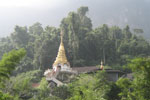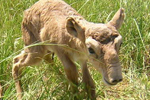Ecotourism doesn’t hurt biodiversity, and in some cases may even safeguard vulnerable areas, concludes a new study from the Amazon in Mammalian Biology. Surveying large mammals in an ecotourism area in Manu National Biosphere, the researchers found that ecotourists had no effect on the animals. However, the researchers warn that not all ecotourism is the same, and some types may, in fact, hurt the very animals tourists come to see.
Still in the Amazon researchers saw only benefits to ecotourism, cataloging 85 percent of large mammals in the ecotourism area as are found in the entire park.
“We could not find any way in which the richness of species has been affected,” explains lead author Salvador Salvador in a press release. “No species sensitive to the presence of humans was lacking and although we were unable to calculate population density, species like the tapir (Tapirus terrestris) or the [white-lipped peccary] (Tayassu peccary) were abundant, even compared to virgin forest areas.”
In addition, ecotourism could even support wildlife populations. According to Salvador, ecotourism in the Amazon tends to focus on areas near rivers, preserving some of the forest under the greatest pressure from settlers.
“These areas are home to species that are attractive, spectacular and easily visible such as the alligators, the giant otter and macaw clay licks,” explains Salvador.
Salvador cautioned, however, that this study should not be seen to cover other ecotourism options, saying “a [photographic] safari in Kenya is not the same as what we studied in the Amazon rainforest.” Most ecotourism in the Amazon is conducted by hiking or in boats.
CITATION: Salvador, Salvador, Clavero, Miguel, Leite Pitman, Renata. “Large mammal species richness and habitat use in an upper Amazonian forest used for ecotourism”, Mammalian Biology (76): 115-123, 2011.
Related articles

(06/12/2011) While few would question that conserving a certain percentage of land or water is good for society overall, it has long been believed that protected areas economically impoverish, rather than enrich, communities living adjacent to them. Many communities worldwide have protested against the establishment of conservation areas near them, fearing that less access and increased regulations would imperil their livelihoods. However, a surprising study overturns the common wisdom: showing that, at least in Thailand and Costa Rica, protected areas actually boost local economies and decrease poverty.
New eco-tour to help save bizarre antelope in ‘forgotten’ region

(05/01/2011) Imagine visiting a region that is largely void of tourists, yet has world-class bird watching, a unique Buddhist population, and one of the world’s most bizarre-looking and imperilled mammals: the saiga. A new tour to Southern Russia hopes to aid a Critically Endangered species while giving tourists an inside look at a region “largely forgotten by the rest of the world,” says Anthony Dancer. Few species have fallen so far and so fast in the past 15 years as Central Asia’s antelope, the saiga. Its precipitous decline is reminiscent of the bison or the passenger pigeon in 19th Century America, but conservationists hopes it avoids the fate of the latter.
Rise in wildlife tourism in India comes with challenges
(04/27/2011) A line of tourist jeeps clogs the road in a dry forest, as all eyes—and cameras—are on a big cat ambling along the road ahead; when the striped predator turns for a moment to face the tourists, voices hush and cameras flash: this is a scene that over the past decade has becoming increasingly common in India. A new study in Conservation Letters surveyed ten national parks in India and found that attendance had increased on average 14.9% from 2002-2006, but while rising nature tourism in India comes with education and awareness opportunities, it also brings problems.







